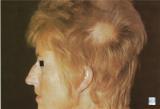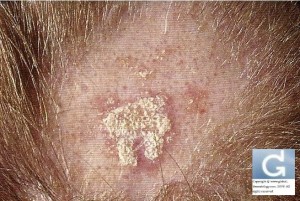Inflammatory Skin Diseases of the Scalp
Inflammatory Skin Diseases of the Scalp
Dr Christophe Hsu – dermatologist. Geneva, Switzerland
Seborrhoeic Dermatitis (Dandruff)
- The cause of seborrhoeic dermatitis is unknown. There are two types of seborrhoeic dermatitis:
- (i) infantile seborrhoeic dermatitis – commonly seen in newborns and babies
- (ii) adult seborrhoeic dermatitis – commonly seen in middle-aged adults.
- Seborrhoeic dermatitis presents with yellowish, greasy scales on the scalp. The underlying scalp skin is red. In mild disease only patchy areas of the scalp are affected. In more severe cases, there may be diffuse scaliness and redness.
- Seborrhoeic dermatitis may affect the skin over the eyebrows, inner cheeks, chest, back and the groin.
- The condition may or may not be itchy.
- Seborrhoeic dermatitis is not a fungal infection although yeast infections have been reported to be associated with seborrhoeic dermatitis.
- Patients with HIV infection may develop very severe seborrhoeic dermatitis.
- Treatment of seborrhoeic dermatitis consists of mild antiseptic or antifungal shampoos and mild topical steroid lotion or gel. The condition tends to be recurrent.
Psoriasis Of The Scalp
- Psoriasis is an inflammatory skin disease characterized by an increased rate of skin cell turnover.
- It presents as plaques with thick scales appearing on the skin and scalp. The skin lesions appear as discrete scaly plaques on the scalp and along the hairline and often extends to the skin of the forehead and sides of the scalp. The plaques are pink and covered by silvery scales.
- Psoriasis is usually non-itchy.
- Nail changes may occur.
- Psoriasis of the scalp is treated with coal tar shampoo and coal tar ointment or topical steroid spray or gel.
Contact Dermatitis and Skin Allergies
- Contact dermatitis is an inflammatory condition caused by an external agent.
- Irritant contact dermatitis of the scalp can occur from overuse of medicated shampoo, chemicals e.g. bleaching lotion, perm lotion and excessive heat applied to the scalp.
- Many topical preparations for hair and scalp can cause skin allergies. The commonest cause of allergic contact dermatitis of the scalp is hair dye allergy. Other possible allergens are fragrance in hair lotion, chemical in perm lotion and medicaments/preservatives in shampoos and hair/scalp lotion.
- Dermatitis presents as itchy scaly red patches on the scalp, hairline and ears. In the acute phase, vesicles and swelling may occur. Eyelid swelling may be seen.
- You should consult your doctor if you have symptoms of contact dermatitis for treatment and investigations to ascertain the cause of the dermatitis. Preventive measures can be taken to prevent relapse. A patch test to ascertain the cause of allergy may be necessary.
Lichen Planus
- Lichen planus is an inflammatory disorder of the skin which can cause bald scarring patches on the scalp.
- The cause of lichen planus is unknown.
- On the scalp it starts off as a reddish purplish patch or plaque which may enlarge with loss of hair. On resolution, the affected skin is scarred and bald. The skin lesions are often itchy, and involvement of the oral mucosa and nails may be seen. On other parts of the body, lichen planus presents as bluish scaly patches which are itchy.
- Lichen planus usually burns itself out spontaneously after a few years.
- Lichen planus of the scalp should be treated early to prevent scarring and permanent balding. The treatment of choice is topical steroids or intralesional injection of steroids on the affected skin.
Discoid Lupus Erythematosus (DLE)
- This is an autoimmune disease affecting predominantly the skin.
- It presents as bald, scaly red patches on the scalp. The skin is thinned out and prominent capillaries may be seen on the patches. Hair loss in these scarred patches are obvious and is often permanent. The skin lesion is painless and not itchy. Other areas of the skin e.g. the face and ears are often affected.Such skin lesions are often sun-sensitive.
- Laboratory tests including a skin biopsy are required to confirm the diagnosis.
- DLE should be treated immediately to prevent progressive scarring and balding of the scalp. There are effective treatments for the disease but scarred lesions are usually not responsive to treatment.
- Occasionally, the internal organs e.g. the lungs, kidneys and heart may be affected by the disease leading to a condition called systemic lupus erythematosus.
- Hence, regular check-up by your doctor is necessary if you suffer from DLE.
Alopecia Areata
- This is an autoimmune disease of the skin.
- The scalp is often affected. It presents as one or more bald patches on any part of the scalp. It is often not preceded by any redness or associated with itch. Bunches of hair just fall off suddenly over a few days leaving behind completely bald patches. The underlying skin appears perfectly normal.
- The cause of alopecia areata is unknown.
- Most patients recover spontaneously after several months.
- In severe cases, the whole scalp may be affected leading to complete baldness.
- The disease is rarely associated with other diseases e.g. thyroid disease.
- Treatment consists of intralesional injections of steroid or painting the affected skin with chemicals that induces allergic reaction at regular intervals. You should consult your doctor for early treatment. Smooth, non-scarring area of hair loss is seen.

Alopecia Areata
Contributors
Dr Christophe Hsu – dermatologist. Geneva, Switzerland
National Skin Centre. Singapore
Español Italiano Português Deutsch 日本語 Tagalog 中文-漢語 русский язык
Category : alopecia areata - Modifie le 11.29.2009Category : contact dermatitis - Modifie le 11.29.2009Category : dandruff - Modifie le 11.29.2009Category : dermite de contact - Modifie le 11.29.2009Category : lichen plan - Modifie le 11.29.2009Category : lichen planus - Modifie le 11.29.2009Category : lupus érythémateux - Modifie le 11.29.2009Category : lupus erythematosus - Modifie le 11.29.2009Category : pelade - Modifie le 11.29.2009Category : pellicules - Modifie le 11.29.2009Category : psoriasis - Modifie le 11.29.2009





